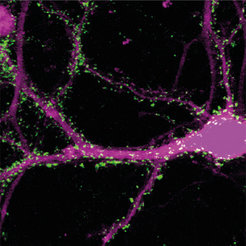New perspectives on RNA function and local protein synthesis in neurons
On the occasion of the 25th anniversary of the journal "Neuronâ", Christine Holt (University of Cambridge) and Erin Schuman (Max Planck Institute for Brain Research) were invited to write a perspective on their views of local processing in brain cells (neurons). The elaborate morphology of neurons has necessitated the "decentralization" of protein synthesis machinery from the cell body to the sites of communication with other neurons (synapses). In the perspective Holt and Schuman describe the evolution of thinking in the field and point to the exciting new areas for future research.

Neurons are special class of cells because they establish communication with up to 10,000 other neurons. The communication points, "synapses" are made up of proteins specialized for the transfer and receipt of information (e.g. neurotransmitters, receptors and associated molecules). A current view is that information is stored by changing the synaptic weight- or strength of communication between synapses. In order for synapses to change, they need access to new proteins. In the past 25 years, the classical view of the protein source arising from the cell body has changed: it is now clear that protein synthesis can occur at synapses- and in the neuronal processes specialized for the receipt (dendrites) and transmission (axons) of information.
Although a more prominent role for protein synthesis in axons and dendrites was suspected for some time, technical difficulties, like the isolation of processes without the soma and discrimination between newly synthesized proteins and already existing ones, hampered the proof of local protein synthesis. With new dissection techniques and newly developed tags to label amino acids, these hurdles have been overcome. Using new-developed techniques like next-generation sequencing and NanoString, researchers from Erin Schuman´s department could detect and identify more than 2500 unique mRNAs at the processes (axons and/or dendrites) of rat hippocampal cells and in Christine Holt´s lab more than 2000 mRNAs were identified in growing axon tips.
While these findings prove local protein synthesis, they also give rise to a large number of new research questions, including the structure of the subcellular compartments involved in protein translation, the transport process of mRNAs to the synapses, the regulation of the local translation and the number of mRNAs required for successful protein synthesis, just to name a few. Interesting from a clinical point of view is the emerging evidence that neurological diseases can be caused by dysregulated local protein synthesis. Finally, an interesting question is whether the local translation is orchestrated by specialized ribosomes, the molecular machinery which is responsible for assembling proteins from amino acids.












